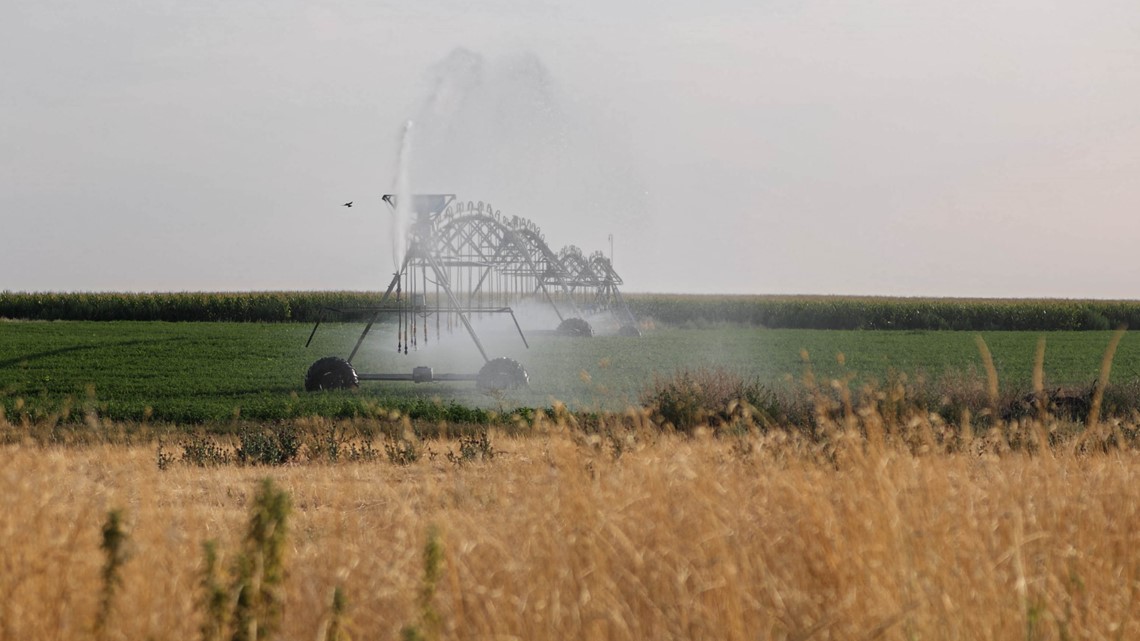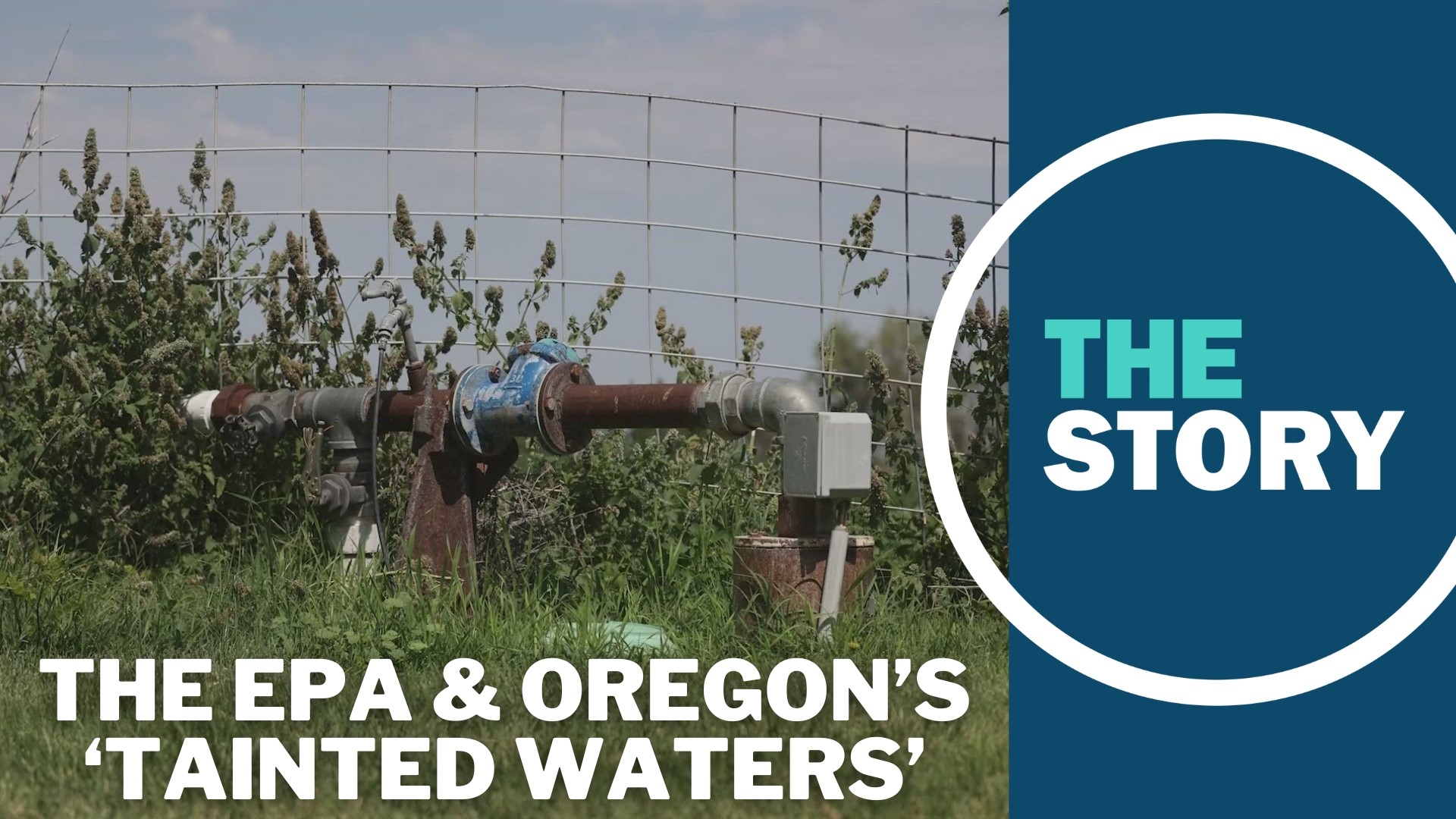PORTLAND, Ore. — Over five nights in November, KGW's The Story documented in its "Tainted Waters" series how a huge aquifer in eastern Oregon came to be polluted, a problem impacting northern Morrow and Umatilla counties. State officials have known about the problem for at least 30 years, and none of the steps they've taken have kept the contamination from getting worse.
In the meantime, thousands of people who use backyard wells — most of them low-income families — are exposed to potentially dangerous levels of nitrates in their water, because those wells all tap into the contaminated aquifer.
Nitrates are known to cause several serious health problems, including cancer, after long-term exposure. The nitrates in this region come from three primary sources: farming, animal feed lots and commercial food processors.
Various committees have met over the last few decades to discuss the problem, and each time, they've recommended voluntary changes in those industries in a vain attempt to stop the pollution. Well-testing in the area has shown that these steps have failed — the pollution is worse now than when it was first discovered.
The Story has tried to get in touch with environmental regulators in order to discuss the issue. Despite repeated requests for interviews with Leah Feldon, director of the Oregon Department of Environmental Quality, an interview has not been forthcoming. The agency responded Thursday to arrange that interview sometime in the days ahead.
But a similar request to the regional administrator for the federal Environmental Protection Agency yielded a very different result. The agency agreed almost immediately to an interview with Casey Sixkiller, administrator for EPA Region 10, and then, it was only a matter of scheduling.
This week, The Story's Pat Dooris sat down with Sixkiller to talk about water contamination in the Lower Umatilla Basin.


'It's time to get the job done'
According to Sixkiller, the problems in Oregon's Lower Umatilla Basin were among the first things he was briefed on after being appointed EPA administrator in 2022.
"To be able to go out there on the ground and actually meet with people that are being impacted by nitrates in their water was a really powerful moment," he said. "I'm so thankful that people open their doors and were willing to come yet again and share their stories and their frustrations."
TAINTED WATERS: Oregon regulators have had decades to tackle the Umatilla Basin's water pollution, but it's only gotten worse
Many of those voices have asked why the government can't step in to reduce the ongoing contamination of groundwater. Sixkiller seemed to think that the more immediate need isn't stopping the pollution but putting in the work to make sure people have access to clean water.
"I said, 'First and foremost, this is an emergency, and we needed to treat it like an emergency.' That's number one: making sure people understand what nitrates in water means and their potential negative impacts to them, to their kids," Sixkiller said. "Two is understanding the ways in which they can begin to understand the extent to which their homes are being impacted by nitrates. And then three, having access to water or filtration or both."
With the emergency steps in place, Sixkiller said, the different government jurisdictions can work on a long-term fix.
Sixkiller grew up in the Seattle area, but he said he often spent summers with relatives down in Vancouver. After taking on his current role at the EPA, he paid a visit to the contaminated areas in eastern Oregon around this time last year.
He said that he's aware that the state of Oregon has stepped up efforts to get wells tested and deliver clean water to people with contaminated wells. But when it comes to actually fixing the problem by getting the agricultural industry to address it, there may be some jurisdictional issues — Sixkiller said it's a decision to be made at the state level.
TAINTED WATERS: The Umatilla Basin's water crisis stems from industrial pollution, but it's hard to pin down one culprit
"But if the state's not making it, can't the feds force it?" Dooris asked. "Because you guys have the Clean Water Act and all that."
Sixkiller said he sees this as an opportunity to explore the EPA's authorities under the Safe Drinking Water Act, as well as the possibility of making improvements through the funding that the Bipartisan Infrastructure Law provided to provide clean drinking water, "and frankly, holding accountable the state and others."


"In this instance though, you know, I am really appreciative of the fact that the state has come to the table," Sixkiller said. "I can't speak for what that interaction was like before I got involved, but I'm encouraged that now we're beginning to see — after a lot of pushing by our agency — to actually have a plan ... not only a plan to deal with the near-term issues of testing and making sure folks have access to water, but also plan to deal with the nitrates that we know exist in the groundwater today — and as you said, you know, the continued application of those nitrates that we know are continuing to have an impact.
"All that's going to require some big changes in the way businesses conduct their business, changes in the regulatory environment or creating a stronger regulatory environment at the state level. But again, you know, folks feel the fire, and I don't know if that's because ... we sent some pretty strongly worded letters to the state or not. I'd like to believe it's because people are agreeing that after three decades, it's time to get the job done."
TAINTED WATERS: Bottled water forever? Morrow and Umatilla residents want to see more action to solve groundwater pollution
Sixkiller said he couldn't speak to a timeline on an actual fix, saying that it will have to be a "very complex solution."
"I can tell you this, and it's the same thing I told the community members when I had the chance to meet with them — we're there now and we're not going away," he said. "I like to think of myself not as an impatient person, but when I see things like this, it's really important that we are transparent and that folks have an ability to hold us accountable. This is not a situation where I think we can wait another three decades. It's not a situation where we can wait another 10 years."
The Oregon Health Authority reports that a total of 424 households are now getting regular deliveries of clean bottled water, paid for by taxpayers.
Sixkiller said that EPA enforcement officials are now meeting every three months with Oregon leaders, talking about what is being done to fix the situation. He said he will not be satisfied until the problem is solved — but he is encouraged to see movement from the state.

